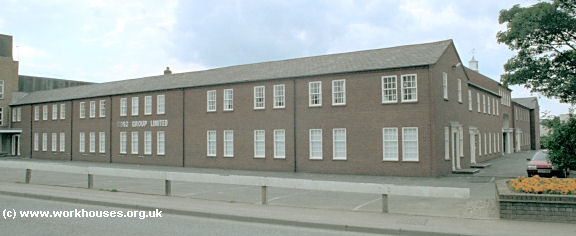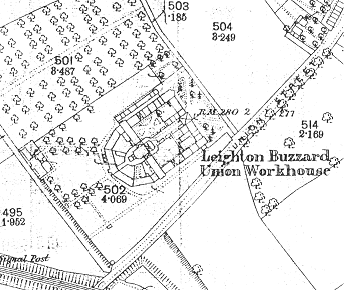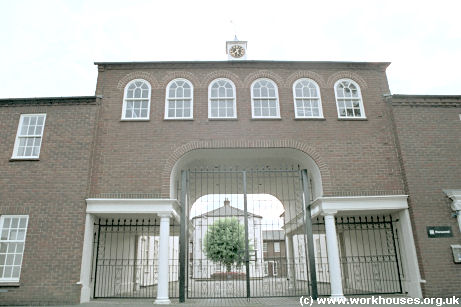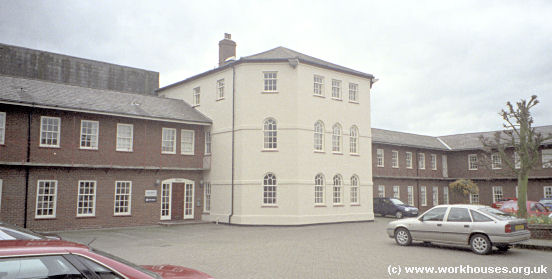Leighton Buzzard, Bedfordshire
Up to 1834
The early workhouse directory, An Account of Several Workhouses..., first published in 1725, noted the existence of a parish workhouse at "Layghton" — presuamably Leighton Buzzard.
A parliamentary survey published in 1777 recorded parish workhouses operating at Leighton Bussard (for up to 60 inmates), Eaton Bray (2), Edelsborough (30), Ivinghoe (50), and Wing (30).
Eden, in his 1797 survey of the poor in England, reported of Leighton Buzzard that:
After 1834
The Assistant Poor Law Commissioner assigned to Bedfordshire, Daniel Adey, had originally wanted to create a large union of 101 parishes centred on Bedford, and making use of Bedford's existing large and efficient workhouse. However, there was strong resistance from local estate owners who much preferred smaller unions where they exert more influnece. As a result, four smaller unions were created at Bedford, Ampthill, Biggleswade, and Leighton Buzzard.
The Leighton Buzzard Poor Law Union was officially formed on 1st July 1835. Its operation was overseen by an elected Board of Guardians, 20 in number, representing its 15 constituent parishes as listed below (figures in brackets indicate numbers of Guardians if more than one):
Bedfordshire:
Billington, Eggington, Heath and Reach, Leighton Buzzard (3), Stanbridge. Later Additions: Chalgrave (from 1899), Eaton Bray (from 1845), Hockliffe (from 1899), Tilsworth (from 1899).
Buckinghamshire:
Cheddington, Eddlesborough (2), Grove, Ivinghoe (2), Linslade, Mentmore, Soulbury, Slapton, Stoke Hammond, Wing (2). Later Additions: Pitstone (from 1923).
The population falling within the union at the 1831 census had been 11,824 with parishes ranging in size from Grove (population 21) to Leighton Buzzard itself (3,330). The average annual poor-rate expenditure for the period 1831-34 had been £11,257 or 19s. per head.
The new workhouse was built to the south of Leighton Buzzard in 1836, on what is now the Grovebury Road Industrial Estate. The Poor Law Commissioners authorized an expenditure of £5,831 on the building which was intended to accommodate 350 inmates. The architect was William P Roote, who was surveyor to the Woburn Estate, and also responsible for the workhouses at Newmarket and NewportPagnell Buzzard, the latter of which Leighton Buzzard closely resembled.

Leighton Buzzard, 2000.
© Peter Higginbotham.
The Leighton Buzzard design was based on a courtyard plan which was popular in Kent, but rare elsewhere in the country. The site layout can be seen on the 1879 map below.

Leighton Buzzard site, 1879.
The workhouse entrance was an archway at the north-east of the site.

Leighton Buzzard, 2000.
© Peter Higginbotham.
The entrance leads to a courtyard which is surrounded by the two-storey accommodation ranges. A three-storey administrative hub lies at the south-west of the courtyard.

Leighton Buzzard, 2000.
© Peter Higginbotham.
To the south-west, an enclosed semi-circular area was divided into smaller yards.
The union was enlarged in 1899 when the adjacent union of Woburn was dissolved. The buildings were later put into temporary use as a prisoner-of-war camp.
The workhouse buildings around the main courtyard survive and are currently (2001) occupied by the Lancer Boss company.
Staff
Inmates
Records
Note: many repositories impose a closure period of up to 100 years for records identifying individuals. Before travelling a long distance, always check that the records you want to consult will be available.
- Bedfordshire and Luton Archives and Records Service, Borough Hall, Cauldwell Street, Bedford. MK42 9AP. Many records survive including: Guardians' minute books and ledgers (1835-1930); admissions and discharges (1891-98; casuals 1914-21, 1926-30); births (1858-1936); deaths (1858-1940); indoor relief lists (1852-1929, with gaps); etc.
- Ancestry
has Bedfordshire Workhouse and Poor Law Records (1835-1914) available online.
Bibliography
- Higginbotham, Peter The Workhouse Encyclopedia (2014, The History Press)
Links
- None.
Unless otherwise indicated, this page () is copyright Peter Higginbotham. Contents may not be reproduced without permission.


